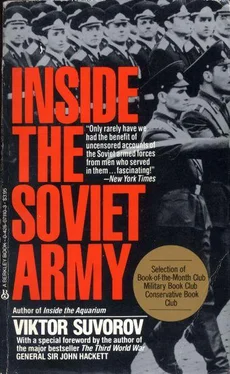The Training of Sergeants
1
Soldiers are glad when their column reaches their new division and they are told that they are joining, for instance, the 207th Motor-Rifle Division, the 34th Guards Artillery or the 23rd Guards Tank Division. They know and are ready for what awaits them. But they are seriously alarmed if they discover that they are joining the 92nd Motor-Rifle Training Division, the 213th Motor-Rifle Training Division or the 66th Guards Motor-Rifle Training Division. The word `Training' has an ominous sound to a recruit. True, it means that he will never be one of the scum, that he will never have senior soldiers above him, but, instead, he will become a sergeant in six months' time, standing above both scum and senior soldiers, as their lord and master. But he knows that for this he will have to pay a very heavy price — six months in a training division.
Formerly each regiment trained its own sergeants. In addition to its four or five battalions and its various companies, each regiment had a `regimental school'. The regimental commander put his best company commander in charge of this school. If the last of an officer's postings contained the words `commanded the regimental school' this showed that at one stage he was regarded as the best young officer in his regiment. The regimental commander devoted equal attention to his choice of platoon commanders from this school and he also sent the most ferocious of his sergeants there. Then each company commander would pick out the most promising of his recruits and would send them to the school. Their training would turn them into real wolf-hounds; they would return to their company with their sergeant's shoulder-boards and lead its soldiers to glory.
But the system of regimental schools had one shortcoming. Different nationalities have differing temperaments and their own traditions. Any Soviet officer will confirm that a Tatar makes the best sergeant of all. Ukrainians are very good sergeants. The Lithuanians are not bad. But the Russian, while he makes a good soldier or a good officer, is not a good sergeant. The great Russian people must forgive me, but this is not just my opinion: it is that of the majority of Soviet officers.
It may, of course, be that all Soviet officers are mistaken but, anyway, the regimental schools certainly accepted all the Tatars they were offered, immediately. They took the Ukrainians and the Lithuanians, too, but Georgians, Russians, Uzbeks and Azerbaidzhanis were given no places. Now, consider what happens when mobilization is ordered. All divisions, wherever they are permanently garrisoned, will call up their reservists and fill all their vacancies. Next second formation divisions — `invisible divisions' are formed. In the process, it comes to light that in the Tatar Republic all the reservists are sergeants and that there are no other ranks. The situation in the Ukraine and in Lithuania is almost the same. In the other republics though, all the reservists are private soldiers and there are no sergeants at all. While it is true that for instance, Georgians make excellent officers, they are not accepted for training as sergeants, because they are too warm-hearted and this makes them ready to overlook trifling mistakes. Trifling mistakes are precisely what a sergeant is concerned with — he must never overlook them and he must punish those responsible without mercy. So, how could you ever build up a division in Georgia?
The General Staff racked its brains for a long time over this problem, but finally adopted the radical solution of disbanding all the regimental schools and of training sergeants centrally, in training divisions.
2
Naturally, the standard of sergeants and their authority dropped sharply as this decision was implemented. Whereas previously each company commander had picked out one of his recruits and told him, `You are going to be a sergeant', now there was no such personal selection. One column of recruits was sent to a normal division, another went to a training division: it was done quite haphazardly. Against that, the General Staff now knows that, under the mobilization plans, Georgia, for instance, needs to produce 105,000 sergeants from its reserve but that in fact it has only 73,000. The remedy is obvious — in the near future the requisite number of new intake columns from Georgia must be sent to training divisions. All the General Staff needs to do is to work out what sort of sergeants it needs — rocket troops, artillery or infantry — and to issue the necessary instructions to local Military Commissars about the numbers they are to send to each training division.
Of course, in formulating these instructions, the General Staff does not forget to ensure that a suitable mixture of nationalities is retained in each division.
3
A training division has the same establishment, organisation and equipment as a normal motor-rifle division. Three of the most important battalions — the reconnaissance, communications and rocket battalions — are combat subunits which are identical with those in a normal division. All the other regiments and battalions of the division keep their weapons mothballed, holding additional weapons for training purposes. The training divisions have no fixed establishment of personnel: every six months each division receives ten thousand recruits to train. After five months of brutally tough training these trainees become sergeants and are sent to combat divisions, to replace those who have been demobilized. Then the training division receives another ten thousand and the cycle begins again. Thus each training division turns out twenty thousand sergeants a year.
Each trainee spends half of his first year at the training division, is promoted and then spends the remaining eighteen months of his service with a combat division.
Training divisions are located only on Soviet territory. If war should break out their current intake would be promoted ahead of time and they would call up their reserves, take their weapons out of storage and function as a combat divisions.
Each of the regiments of a training division trains sergeants in one particular field, following a specialised curriculum. The artillery regiment trains 1,500 artillery sergeants, the engineering battalion turns out 300 engineer sergeants with varying specialist qualifications, and so forth. A very large proportion of tank crew members pass through the training divisions, since the commander, gunner and driver of a tank are all NCOs: only the loader is a private soldier. Since the newest Soviet tanks carry no loaders, every member of a tank crew will henceforth pass through a training division. In the artillery the proportion of sergeants is much lower. In the infantry, units with armoured personnel carriers have one sergeant to each section, those with infantry combat vehicles have three sergeants to each section. The training of sergeants in the various different fields proceeds in accordance with the requirements of the combat divisions.
In the tank training regiments, the first battalion usually trains tank commanders, the second, the gunners and the third, the drivers.
At the conclusion of their training all trainees sit examinations. If they pass them the specialists (gunners, tank drivers, radio operators etc.) become lance-corporals; those who pass with distinction become junior sergeants. Gun-, tank- and section-commanders become junior sergeants: those who pass with distinction receive immediate promotion to sergeant.
4
A training division has no scum or senior soldiers. All 10,000 recruits arrive and leave the division at the same time. The division does, however, have sergeants, and their influence is a hundred times greater than that of the sergeants in combat divisions. In a combat division, while a sergeant must not be over-familiar with his senior soldiers, he must at least respect them and take their opinions into account. In a training division, on the other hand, a sergeant simply dominates his trainees, totally ignoring any views they may have. In addition, each platoon commander in a training division, supervising thirty or forty young trainees, is allowed to retain the services of one or two of the toughest of them. A sergeant in a training division also knows that he would have nothing like the same authority in a combat division. While he is still a trainee, therefore, he picks noisy quarrels with his fellows, in the hope that his platoon commander will notice and decide that he is someone who should be kept on to join the staff after the end of the course. He cannot afford to reduce his aggressiveness if he succeeds in landing a job with the training division, or he may find himself sent off to join a combat division, having been replaced by some young terror who is only too ready to spend all his nights as well as his days enforcing order and discipline. (If, however, this should happen, he would soon realise that he is unlikely to be sent on anywhere else from a combat division and that he can therefore afford to let up a bit and to slacken the reins.)
Читать дальше












